|
FAQs about Faviid Coral Predators, Pests
FAQs on Faviid Disease:
Faviid
Disease 1, Faviid Disease
2, Faviid Disease 3,
Faviid Disease 4, Faviid Disease 5, Faviid Disease,
FAQs on Faviid Disease by Category:
Diagnosing,
Environmental (Pollution/Poisoning, Lighting...),
Nutritional, Social (Allelopathy),
Trauma,
Pathogenic (Infectious, Parasitic, Viral)
Treatments
Related Articles:
Coral Pests and Disease; pests, predators, diseases and conditions by Sara
Mavinkurve,
Faviid
Corals,
FAQs on Stony Coral Disease: Stony Coral Disease 1, Stony Coral Disease 2, Stony Coral Disease 3, Stony Coral Disease 4, Stony Coral Disease 5, Stony Coral Disease 6, Stony Coral Disease 7, Stony Coral Disease 8, Stony Coral Disease 9, Stony Coral Disease 10, Stony Coral Disease 11, Stony Coral Disease
12, Stony Coral Disease 13,
Stony Coral Disease 14,
Stony Coral Disease 15, Stony Coral
Disease ,
FAQs on Stony Coral Disease by Category: Diagnosing:
Environmental (Pollution/Poisoning, Lighting...),
Nutritional, Social (Allelopathy),
Trauma,
Pathogenic (Infectious, Parasitic, Viral)
Predatory/Pest,
Treatments
FAQs on Stony Coral Disease by Type: Brown Jelly Disease, RTN,
|
|
|
Trumpet Coral Problem 10/1/15
Dear Wet Web Media,
<Wendy>
I am having a massive loss of yellow trumpet coral and looking
for ideas as to why.
<Will give you the principal sources: predation, environment (ho boy), lack of
nutrition, allelopathy....>
All other fish (6 small), various hermit crabs, snails, starfish, anemones (5
keep splitting)
<Mmm; near by?>
and corals
<See you've listed these below; good>
are acting normally.
165 gallon
4 years old system
Aqua C EV skimmer/LEDs/co2 reactor/refugium/wave maker
SG 1.025, 79-81.5 F temp, Alk 10-12, Calcium 435, magnesium 1340, 0
nitrates, 0 phosphates,
<Ooops! Here's at least part of the "issue"; a lack of N, P, K.... READ here:
http://www.wetwebmedia.com/FavNutrDisF.htm>
20% water changes weekly
<And you dose iodide/ate then?>
The tank has few SPS (birds nest, much monopora), many LPS (frogspawn,
plate, chalice, brain), and 2 large soft corals (toadstool leather and
Sinularia), a couple mushrooms, Ricordeas and some Zoanthids.
<Again; allelopathy is a concern here as well... some of the more chemically
aggressive organisms you have can/do poison other Cnidarians distally at times;
esp. ones that are otherwise compromised (starving in this case)>
No new corals have been added, all have been thriving. I do have a bright yellow
encrusting sponge that I am trying to keep under control.
<This might be a contributor as well>
The trumpet corals have been growing like crazy. I started out with 2 heads
eight years ago and now have 300+ and have traded away 100+.
<Ah, good>
Anyhow, I was gone on vacation (1 week) and think the tank care giver was
feeding too much. (pellets and rinsed frozen food) Upon my return phosphates
were too high, so immediately I did water changes and added PhosBan media to an
extra media reactor I had in my LifeReef sump.
Phosphates were 0 in a few days.
<.... all chemo-photosynthetic life needs measurable soluble HPO4>
Soon after, I lost 2 trumpets (tissue recessed from bottom until dead
in few days). I assumed it was a freak out from phosphate elevated.
<Actually; the opposite>
Well, it's been a month and now the trumpet loss is epidemic, as I have 25% of
the trumpet heads dead or in recession. I have continued to care for the tank as
usual, testing is fine and good water changes. I see no critters on any corals.
What else can I do?
<The I2 mostly; multiple dosed; as you'll find in your reading; removal of the
chemical filtrants...>
I am not even sure the loss is due to a fluctuation in phosphate...?
Should I remove all dead heads and recessing heads or wait it out?
<I'd leave all in place>
Should I do a lugos dip on all trumpets colonies?
<Better to add to the system itself>
What other tests can I do?
<How much time do you have to read?>
Why would only the trumpets (which are spread all over the tank, up and down and
middle) be receding and dying?
<They're on the "losing" side of allelopathogenic "strength" here, and more
susceptible to nutrient deficiency>
Thanks so much! Really, thank you very much for your advice.
Wendy
<Cheers, Bob Fenner>
|
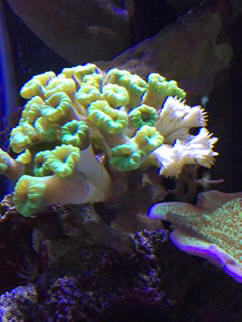 |
|
Re Trumpet Coral Problem, caused by Yellow Encrusting Sponge?
10/6/15
Hi Bob,
<Wend>
Thank you for your opinion on why my trumpet corals are recessing.
Here is some more info:
The anemones are not near the trumpets.
I do add iodide.
I target feed the trumpets and feel they are getting plenty of nutrients or else
they would not be multiplying so fast prior to this mass recession.
(2 to 400 heads in 8 years)
The refugium is full of macro algae and I battle hair algae in the overflows.
Allelopathy could be part of the problem.
My latest thought is in relation to the Jaspis serpentina sponge which is slowly
taking over my tank. A few weeks ago, I was scraping it off the back glass and
trying to dig it away from taking over some Zoanthids and birds nests.
Would the small sponge particles within the water column cause the trumpets to
die off?
<Yes; could>
Would you recommend removing rocks that have this encrusting yellow sponge on
it?
<Yes I would... rinse, chip off; possibly bleach... but at least allow to air
dry for a week or more before re-using>
There is a LOT of yellow sponge in my tank. What does happy yellow sponge
indicate about the tank?
<Propitious circumstances; at least for it. BobF>
Thank you,
Wendy
|
|
Candy cane coral 6/22/12
Hello crew,
So I ordered a shipment of corals off from reefs2go.com and one of them
was a frag of candy cane coral. I saw that there was something in
the head of the coral and panicked because it was killing the coral (I
think) because the skeletal structure was showing were the worm or
something was living.
So naturally I took a knife and cut it out and killed the little pest so
then there is this huge hole in the polyp the rest of the coral looks
fine but these are my first corals so I am wondering... will it recover?
<Yes; should, given good conditions...>
I hope so I am very excited about this coral and I would like to know if
it will recover soon.. here is a picture tell me what your thoughts are
please
Thank you so much
<I'd do a bit of over-dosing w/ iodide-ate... Have you read on WWM re
Caulastrea care? I would. Bob Fenner>
|
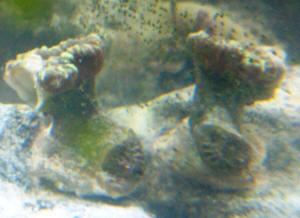 |
|
LPS -- 05/28/2010
I don't know if you guys can see the picture I am attaching,
if you can could you tell me if this candy coral is healthy
<It's alive. There appears to be some significant
recession of the tissue, but it looks generally ok.>
and also help me to identify the small shell looking creatures
taking over my rock.
<? I'm not sure I see what you're referring to,
sorry.>
I am worried because he still does not put out his feeders I have
only had him a couple of weeks. I know he was previously only
kept under one NO actinic light at the LFS for quite a while
before I bought him. My water parameter's are nitrate 0
nitrite 0 ammonia 0 ph 8.3 sg 1.025 temp 79 calcium 420 DKH 12.6
I also dose with magnesium and iodide when needed. I also do
weekly water changes adjusting calcium, DKH, ph, and sg to match
my tank. I only use RO/DI water for all purposes. I have these
under 124w of t5 HO 96w is 12k and 24w is actinic. My occupants
are 1 goby, 1 Percula clown, 1 coral banded shrimp, 1 arrow crab,
5 blue legged hermit crabs, 6 Astrea snails, 2 margarita snails,
2 Nassarius snails, and 1 peppermint shrimp. Everyone seems to
get along or at least they have until now, and I do plan on
getting rid of the arrow crab as soon as he finishes up the bulk
of my Fireworm problem.
<Fireworm problem? Not really any such thing... they're
beneficial. I wouldn't try to get rid of them.>
I have not seen any of the crabs or shrimp preying on or
bothering this coral and I have looked at all hours of the night.
Also I do run a Coralife 65g skimmer on this 29g system and
activated carbon. Any of your advice would be much appreciated
and used. Thank you again.
<How old is the tank? It's hard to keep corals in small
systems (no matter what you do)... especially if they're not
very well established.
Best,
Sara M.>
LPS, RMF's usual testy go 5/28/2010
I don't know if you guys can see the picture I am
attaching,
<Yes... even though it's much larger than what we ask
folks to send along...>
if you can could you tell me if this candy coral is healthy
<Is not... the algae, colour... >
and also help me to identify the small shell looking creatures
taking over my rock.
<The little white squiggles? They're Serpulids...>
I am worried because he still does not put out his feeders I have
only had him a couple of weeks. I know he was previously only
kept under one NO actinic light at the LFS for quite a while
before I bought him. My water parameter's are nitrate 0
nitrite 0 ammonia 0 ph 8.3 sg 1.025 temp 79 calcium 420 DKH
12.6
I also dose with magnesium and iodide when needed. I also do
weekly water changes adjusting calcium, DKH, ph, and sg to match
my tank. I only use RO/DI water for all purposes. I have these
under 124w of t5 HO 96w is 12k and 24w is actinic. My occupants
are 1 goby, 1 Percula clown, 1 coral banded shrimp, 1 arrow crab,
5 blue legged hermit crabs, 6 Astrea snails, 2 margarita snails,
2 Nassarius snails, and 1 peppermint shrimp. Everyone seems to
get along or at least they have until now, and I do plan on
getting rid of the arrow crab as soon as he finishes up the bulk
of my Fireworm problem.
I have not seen any of the crabs or shrimp preying on or
bothering this coral and I have looked at all hours of the night.
Also I do run a Coralife 65g skimmer on this 29g system and
activated carbon. Any of your advice would be much appreciated
and used. Thank you again.
<Have just skipped down. Read here:
http://wetwebmedia.com/FaviidDisF3.htm
and the linked files above, and re the Polychaete family
mentioned. Use the search tool/indices on WWM ahead of writing
us.
Bob Fenner>
|
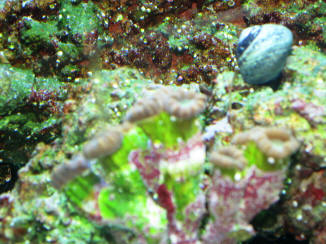 |
Healing Favites 7/25/07 To the
truly amazing staff at WetWeb, <I'm good with this. There are
some wonderful people here!> I am new to marine systems, <Welcome
o the briny world CJ!> with a year old 60 gallon and a copy of Mr.
Fenner's book- which drove me to become the marine junkie I now am.
<Mmm, yep, been there.> I follow Mr. Fenner's advice
religiously, <You are wise. Thought the website is more up to date
than the book with some things.> and what I cannot afford, I make.
<You are lucky to have these skills.> My tank somehow became a
refuge for rescued fish and coral. Sadly, I usually receive neglected
animals that this site recommends not be collected or sold. <This is
sad.> Although constantly daunted, I am quite proud of my unexpected
successes. (Those at WetWeb should be too, as this site is my largest
reference!) <Good to hear!> The issue: I recently acquired a
Favites in terrible condition. It is eating now, and plumping up a bit-
no problems there. <Very good!> However, when I received the
Favites, it had receded to approximately one third (flesh covering
skeleton), perhaps due to lighting or feeding. (I have many pictures,
if you need one). <Pictures usually help.> It must have been this
way for some time, <Likely so.> as the exposed skeleton is
covered in coralline, and along the periphery of flesh are a handful of
what I thought where small feather dusters. Upon concentrated
inspection, these dusters' appear to be some type of tubeworms that
secrete a 'slime web', and have no head. <Sounds like small
worm snails of the family Vermetidae, generally harmless filter feeder
casting out their mucus net to collect food.> I would like to know
if I should attempt to remove the worms, and if they are harming the
Favites (or inhibiting it's healing). <Generally no, these
should create a problem, not unless there is a significant amount of
mucus that the coral had difficulty removing.> I believe this poor
guy might come back, if helped along. <Hopefully!> I appreciate
any advice that can be given, and thank you so much for taking the time
with this, and every question. --CJ <Thank you for your kind words.
You are most welcome! Mich>
| Propagation-the hard way
12/27/06 Hi Crew, <Greeting! Mich here.> With
all of us writing in our problems, the casual observer may get the
idea that this hobby is just a pain. <Hehehehehe! But
we all know better!> But there is lots to enjoy and there are
many surprises. <This is true, even more true when the surprises
are good!> I did not intend to split my candy cane which has two
branches. <Hee! Intent and action are not always
equivalent.> One branch has one very large polyp and a second
branch that used to be one but now is 3 distinct polyps
<polyps>. <Growth is good.> I have a glass cover on my
tank, the kind that has a plastic hinge in the middle. I removed
the hinge and have two glass pieces with a half inch gap between
them. Somehow I managed to drop one glass into the tank and it hit
the candy cane and I now have two candy canes, one with 3 polyps
and no base and the other with a base and one polyp. <Oops,
accidental fragging.> I just stuck the branch into a small hole
in my rock and all seems well. <Should be,
hopefully.> I have a mushroom that I bought about 3 months ago.
It is on a two inch rock covered with purple coralline algae. I
noticed a small lump at one side of the rock and now it is a nice
Zoanthid polyp with a peach colored mouth. <A good
surprise! Very nice.> I just discovered a feather
duster under the mushroom. It open up to about the size of a shirt
button and the mushroom lift up as if to give it some breathing
room. The feathers start off as a grey/blue color and at the tips
they are yellow. The feathers look like they are v shaped and it
looks as if there is a black barb at the end of each yellow end.
<It sounds quite beautiful!> I look around quite often and
was surprised that I had not noticed it before. <I think you
could almost see something new everyday if you are observant
enough. It is an awe inspiring hobby! Thank
you for sharing some of your delights. It is always nice
to hear!> Happy holidays. <Wishing you the best
of the season! -Mich> |
| Caulastrea - potential parasite - 05/22/2006 Hello
crew, <Bob... it's... Bob> I wanted to thank everyone for
all the help I've received from reading you
FAQs. Finally, after 8 months in the hobby, I have a
question that I can not find the answer to. I purchased
a Caulastrea coral about two weeks ago and the coral is currently
in quarantine. <Good> All polyps seem to be doing well except
for the one that is shown in the attached photo. <Great pic>
Several times in the past two weeks I have noticed a brown
substance being expelled from the malformed polyp, which I assumed
to be Zooxanthellae. <Mmm, or just waste...> However, a few
days ago I noticed what appeared to be a tube was protruding from
the mouth of the polyp. Also, although it can't be
seen in the photo, I have noticed what appear to be two ~2mm long
antennae protruding from the tube. Finally, unlike all other polyps
this one has never extended its feeding tentacles at night. Any
help you could give me about the nature of this potential parasite
and any actions that could be taken to remove it would be much
appreciated. Thank, Mark <Might be a boring organism... likely a
worm/Polychaete, or possibly just the polyp recovering from
collection, shipping trauma... I would continue your observation,
finish the quarantine and place this animal. If it is indeed a
parasite, space or more deleterious in nature, it will likely
perish in time (and not reproduce) in your main system. Bob
Fenner> |
|
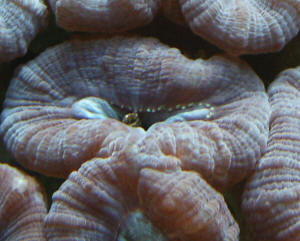
|
| Candy Cane and Anthelia questions 8/1/04
Hello. I've spent many hours on your site and I must say
it's a great resource. <Great to hear!> I have a question
about a stony coral I have (candy cane). Last night I put a
flashlight on it and noticed that between the stony columns is
growing a yellow kind of "fuzz" or something. I am not
sure if it is a disease or algae or what. Otherwise the coral looks
healthy. Inflated during the day and tentacles out at night for
feeding. You can only see this stuff at night when it's
slightly deflated. I have attached an image so you can see what I
mean. We've had the coral for about 3 months now
with no problems. <This is nothing at all to worry
about. It is an encrusting sponge and a very common
occurrence between the branches of stony corals.> Several other
corals in the tank are soft ones. This is the only hard coral. The
tank is a 45 gal less than 6 months old, all readings are zero,
calcium is at 440 and pH is at 8.2 (we originally started it from
cycled water from our aquarist friend back then). I reduced the
picture and have a larger one if needed. On another note, the
anthelia has been struggling for days. I suspect it's the pH
but I am not sure since it's not excessively low. Would it help
to raise it and by how much? Also, there is a "life-form"
attached near by and I wonder if this is affecting it. At first I
thought it was a new colony of anthelia but now I wonder if it is
an unrelated different coral. A picture of this is attached as
well. Thank you for your help. Daphne <A pH of 8.2 is
perfect. What about alkalinity? IMO,
Alkalinity is probably the most important parameter to test
regularly in a reef tank. The coral in the picture is
actually Clavularia. There are several things growing
within and around it: Valonia (bubble algae), hair
algae, some Caulerpa and some kind of mushroom
anemone. Any or all of these things could be affecting
the Clavularia. I would try to move the mushroom, test
alkalinity and correct with a good quality buffer if necessary and
be sure that you have plenty of water movement. This is
a tough coral that should recover easily under good
conditions. Best Regards. AdamC.> |
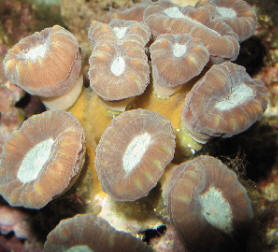 |
 |
Gall crab 1/13/04 I have what I believe to be a
female gall crab living in my closed brain coral. Should she
be removed? Thanks much! Jeff Wagner <they are rarely a problem my
friend... the coral will usually grow around them. If your coral
exhibits normal polyp cycles and feeding... no worries. Anthony>
Torch or Candy Cane coral Hello Crew, Another
day in this excellent hobby. Another day to worry about things huh?
Quick question. Do Candy Cane corals recover from damage? I have a
cluster with 9 polyps but recently I was on vacation for 3 days and one
of my triggers damaged 3 of the polyps (1 now has tissue only in the
middle - and the other 2 were partially bitten). Will they grow the
stony part back (assuming they will not get damaged again? I made the
mistake and left the lights on every day and the trigger, which was
left unfed, turned against it. I have previously left my fish unfed for
a weekend or so but with no incident. I've had this coral for a
year. I am adding iodine/calcium/trace elements as per direction. I can
see the tissue on the coral trying to connect but I'm not sure if
the stony part will grow back? >>The coral should recover and the
stony part may or may not grow back. The important part is to make sure
there is no further damage. Are you testing for iodine and calcium and
other trace elements? A good rule of thumb is to only add what you can
test for because otherwise you can easily be overdosing or just wasting
money. I am not a big fan of adding anything other than a two part Ca
solution regularly, and with regular water changes your trace element
levels should stay at the correct level. Rich>> Keep up the good
job - I always consult your site when in doubt. It is an excellent
source for reference. Have a nice day.
Dimitri
|
|

